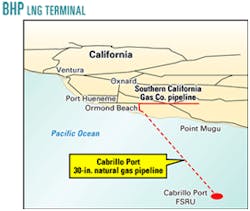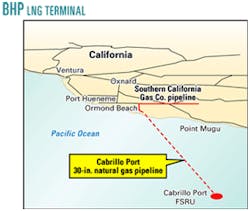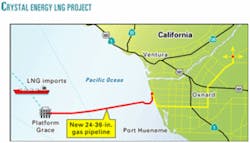A second proposal to develop an LNG import terminal in the Santa Barbara Channel off Ventura County, Calif., has emerged, and both projects face an uphill battle against fierce local opposition.
Sponsors unveiled project details and supportive arguments at the first public workshop on the projects last month in Oxnard, Calif. (see maps).
One proposal, by Houston-based Crystal Energy LLC, would convert the existing Platform Grace, 11 miles offshore, into an LNG offloading and regasification terminal with no storage. Crystal Energy last month let contract to OPE Inc., Houston, to perform conceptual engineering for the proposed $125 million LNG offloading hub.
The other proposed project, backed by a unit of Australia's BHP Billiton Petroleum Ltd., would entail a permanently moored floating storage and regasification unit (FSRU) 21 miles offshore at a cost of $550 million (OGJ Online, Aug. 18, 2003).
A previous proposal by an Occidental Petroleum Corp. subsidiary to construct an LNG facility onshore, also in the Oxnard area, was thwarted last year when the state Coastal Conservancy purchased the property, while a 1977 LNG proposal failed to get beyond initial proposals. Each one was met with strong public and political opposition.
Neither of the new proposals was welcomed in the Oxnard workshop, as opponents cited fears of fire, leaks, earthquake, and terrorist attacks.
Detailed applications could be filed within the next few months with the US Coast Guard as the lead permit agency and numerous permits and reviews required from the State Lands Commission, US Department of Energy, California Coastal Commission, and various local agencies.
Project details
Design sendout for each project is at least 800 MMcfd of gas. Both projects would regasify imported LNG and use subsea pipelines to tie into existing Southern California Gas Co. pipelines onshore in the Oxnard area of Ventura County.
Crystal Energy, of Delaware and a subsidiary of energy trader William Perkins's Small Ventures US LLC, proposes to convert the existing and nonproducing Platform Grace into an LNG regasification terminal.
The gas then would be shipped via a new $160 million pipeline that would tie into the SoCalGas grid at Oxnard near the Mandalay Bay power plant. Capacity would range from 800 MMcfd to 1.25 bcfd, fed by spot and contract LNG cargoes. No storage is proposed at the platform.
The so-called Cabrillo Port project backed by BHP would develop a double-hulled FSRU equipped with three storage tanks with total combined capacity of 125,000 tonnes of LNG (6 bcfe) and regasification capability rated to 1.5 bcfd.
A subsea pipeline of 21 miles would tie gas from the FSRU into the SoCalGas grid near Ormond Beach in Oxnard.
Crystal LNG contract
OPE will develop a floating dock system incorporating its patented SSP moored buoy as a bumper system for LNG tankers approaching the existing fixed Platform Grace (see illustration). Crystal Energy has brokered a 10-40 year lease from Santa Barbara, Calif., independent Venoco Inc. for long-term use of the platform, pending acquisition of all permits.
The platform will serve as the import-regasification point for 200 bcf/year of LNG supplies from sources such as South America, the Pacific Rim, and the Middle East (OGJ Online, Nov. 4, 2003).
An existing pipeline right-of-way connects the platform to shore, and a new, 36-in. pipeline would deliver natural gas to existing onshore facilities. A potable water pipeline also is proposed along the existing pipeline corridor to deliver 40 million gal/year of fresh water from the regasification process to Oxnard.
OPE expects to receive an approval in principle by yearend and plans to have the terminal area ready to accept LNG by 2007.
Making their cases
Company executives touting the benefits of their respective projects focused on California's recent problems with energy supply security and energy cost spikes.
Crystal Energy representative Simon Poulter showed a BP PLC LNG video on safety, in which a scientist snuffs out a cigarette in LNG, a goldfish swims unharmed even with LNG poured on top, and another scientist drinks water after the LNG had vaporized.
"LNG, when properly used, is not the monster that's been depicted," Poulter said.
In an earlier hearing at the Oxnard City Council, California Energy Commission official Kevin Kennedy urged citizens to keep an open mind. Kennedy, supervisor of special projects with the CEC, acknowledged "some degree of danger with any natural gas pipeline," but he noted a good national safety record for LNG with only two major accidents, in 1944 in Ohio and 1979 in Maryland, with no shipping accidents and increased state-of-the-art safety technology.
The company representatives also told the workshop audience new LNG facilities could reduce energy costs, as California imports up to 90% of its natural gas supplies. Other benefits cited were natural gas's air quality benefits and the hedge that increased gas supplies would create against a repeat of electric power blackouts through their ability to serve over a dozen new power plants built in recent years.
"Our demand for natural gas is rapidly outpacing our available supply," said BHP Billiton. "California's options for natural gas are increasingly uncertain."
Perkins, president of Crystal Energy, said that "demand projections call for a 20% increase [in California's gas demand] in this decade" and that other western US states that provide natural gas to California "are now using more of the supply for their own needs, leaving the state with a severe shortage."
Using an existing offshore platform is a quick and relatively low-cost way of meeting such demand, Perkins said.
The projects are proposed at a time when DOE has launched an LNG education campaign to counter what energy regulators say are popular misconceptions about the fuel (OGJ, Sept. 22, 2003, p. 36). Federal regulators recently approved the first new LNG terminal to built in the US in 25 years. There are only four LNG import terminals in the US, all onshore with three on the East Coast and one on the Gulf Coast, supplying about 1% of US gas supply.
Still, opposition is expected to be fierce against the California projects. Candidates for a Ventura County supervisorial election—including the mayor of Oxnard, who quipped, "I wish they would build it in Australia"—all oppose any LNG terminals. Some local and state politicians are also wary of the proposals, and environmental groups already are girding for a long fight.



